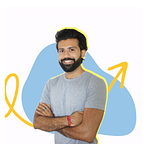How I got much better at Maths (in 12 months)
A maths teacher + 10 years in quant-y finance stuff = he must love maths, and have always been good at it right?
Truth is, I’ve often struggled with the subject.
Don’t believe me? Here’s a snapshot of my degree transcript..
So how did I become confident enough over the past year to teach it up to A-level?
Here’s what I did..
1. Peak
There’s a fantastic book written by world-renowned psychologist Anders Ericsson called Peak: secrets from the new science of expertise.
The 60-second summary? The key to mastery in anything is deliberate practice.
Pick one element of mathematics, say, not knowing where to start a question. Then isolate that skill alone. Rather than answering lots of questions, you’d just go through a bunch of problems and figure out where you’d start. That’s it. No goal of getting to the end, or the right answer. Just developing that one isolated skill, then on to the next isolated skill.
2. I rewrote my “story” about mathematics
You know, the one we decide in our teens and then settle on for the rest of our lives. For me that went from:
“What’s the point in this hard arbitrary stuff that no one ever needs.”
to
“What fascinated all these philosophers and scientists in the past about this? Why did they think it was worth pursuing? What were they trying to figure out?”.
Gamechanger.
3. YouTube
I’d watch 3Blue1Brown just for fun. They create absolutely stunning visual breakdowns of complex ideas. YouTube + pen + paper = epic.
Or here’s Eddie Woo on cryptography.
I wish this guy was my maths teacher. Witty and so easy to follow along. Now it serves the dual purpose that I can bring (steal) some of these stories to my classroom.
4. Symbolab
If you’re ever stuck on a question, there are now tools that show you line by line worked solutions. No more flicking back and forth between the exercise and the answers at the back of the book. No more scrunching up your paper and seeing how good your basketball shot is. Just beautiful and immediate worked solutions that show you the light. Here’s an example.
Question:
Answer:
5. Visualisation
I only recently found out about Maryam Mirzakhani. She’s truly remarkable. This woman struggled with mathematics when she was younger, and yet rose to win the highest accolade there is for any mathematician — the prestigious Fields Medal.
Her secret was taking her time, and growing her ability to visualise problems.
Tragically she died at the tender young age of 40, leaving behind an immense legacy for young female mathematicians.
The inspiration I took from her was to try to make better use of our subconscious brain. So rather than anxiously try to cram in content from podcasts and audiobooks (as though I was in some intellectual arms race), I’d go for a walk, leave the phone, and think deeply about one aspect of a problem. I’d let that ruminate. Sometimes I’d sleep on it. I don’t pretend to understand how it works, but creative visualisation of maths really does work.
Summary
So, to summarise:
- Deliberate practice of an isolated skill
- Change my ‘story’
- Two YouTube channels
- Symbolab
- Visualisation
I’ll leave you with this thought, which was also my desktop wallpaper.
I’m currently doing my PGCE at Oxford University and working at a nearby secondary school, teaching Mathematics. I comment on themes from Education & Learning, and how they might benefit you, and the next generation.
Subscribe here: www.theedletter.com
